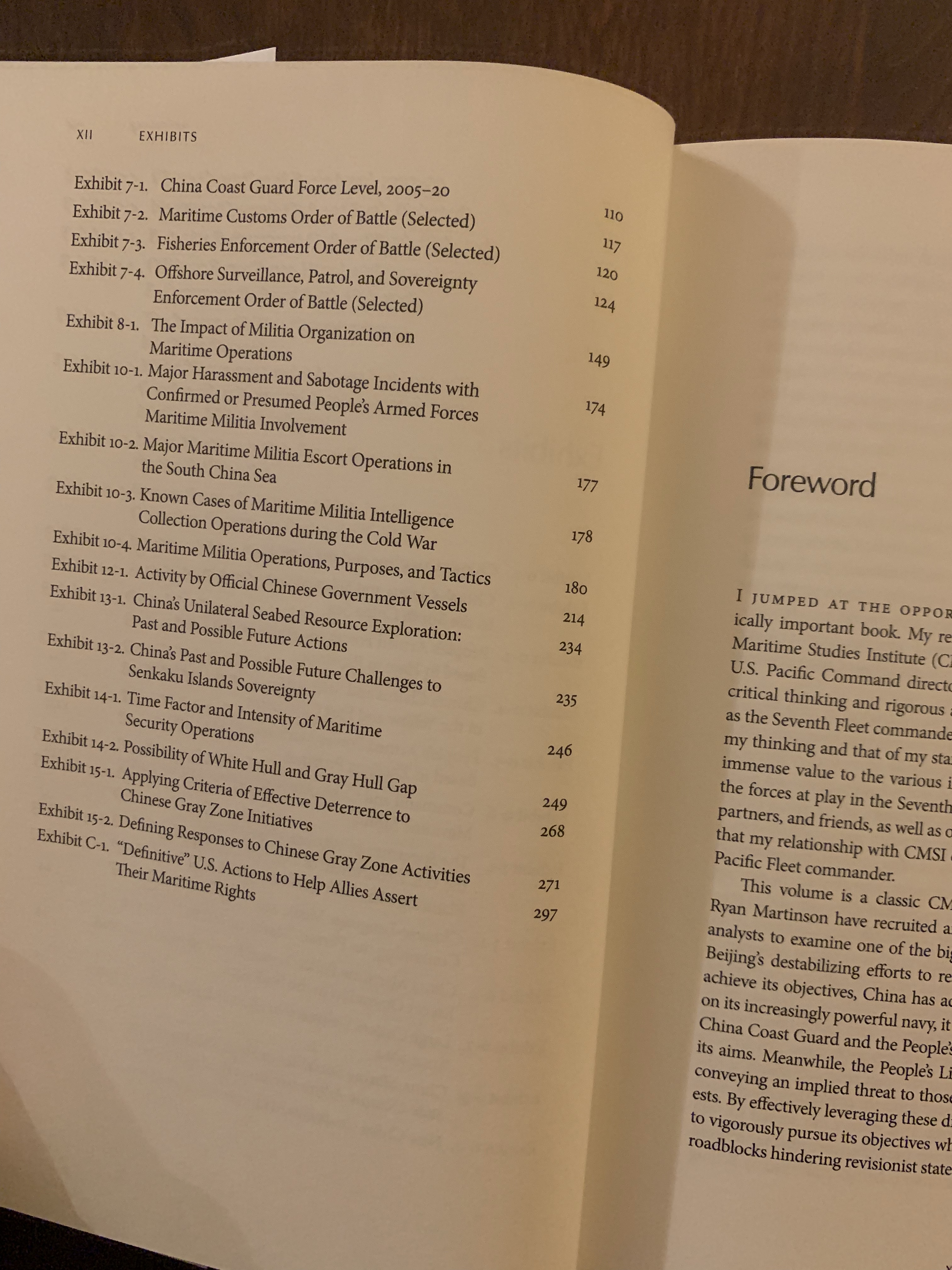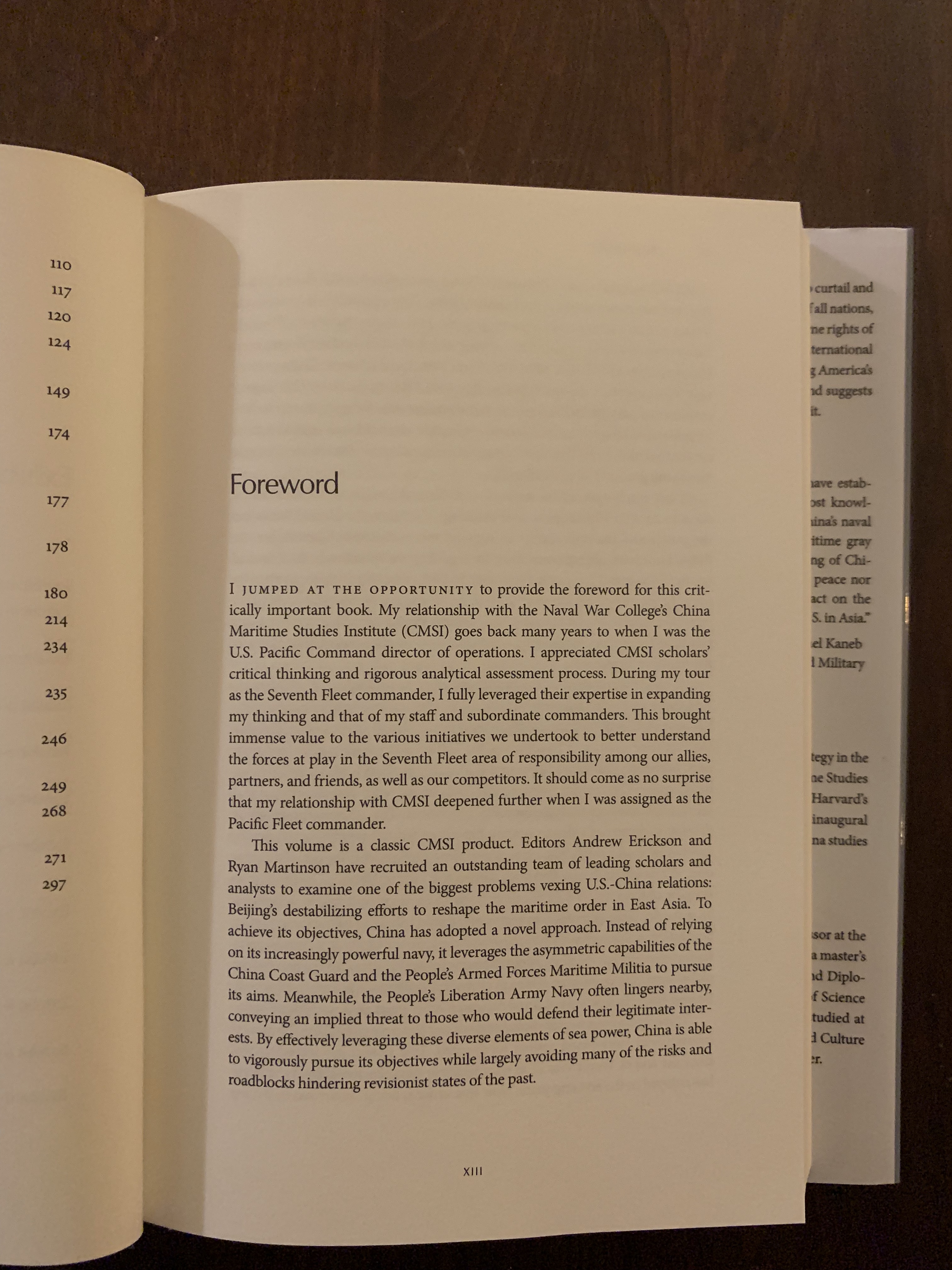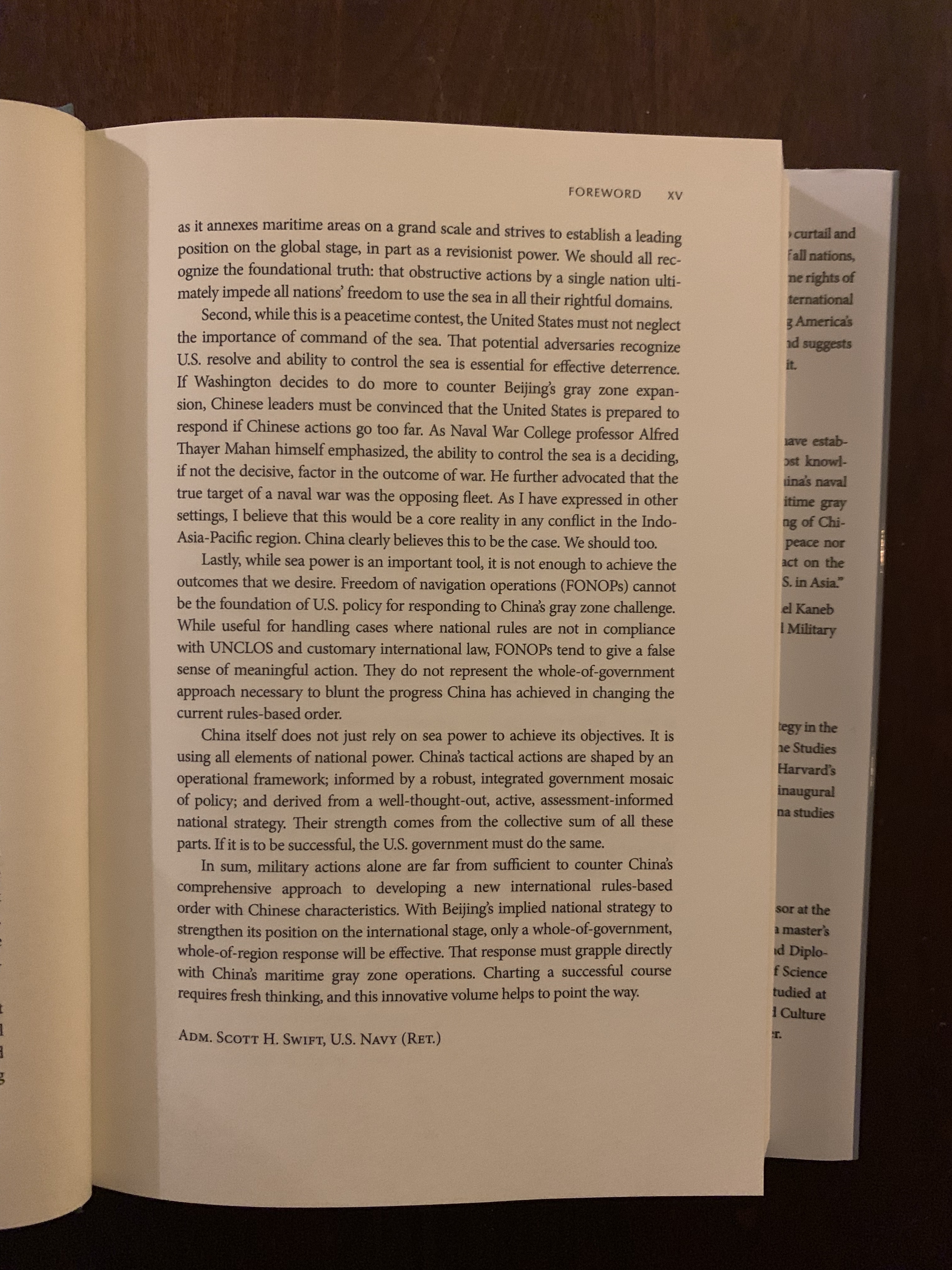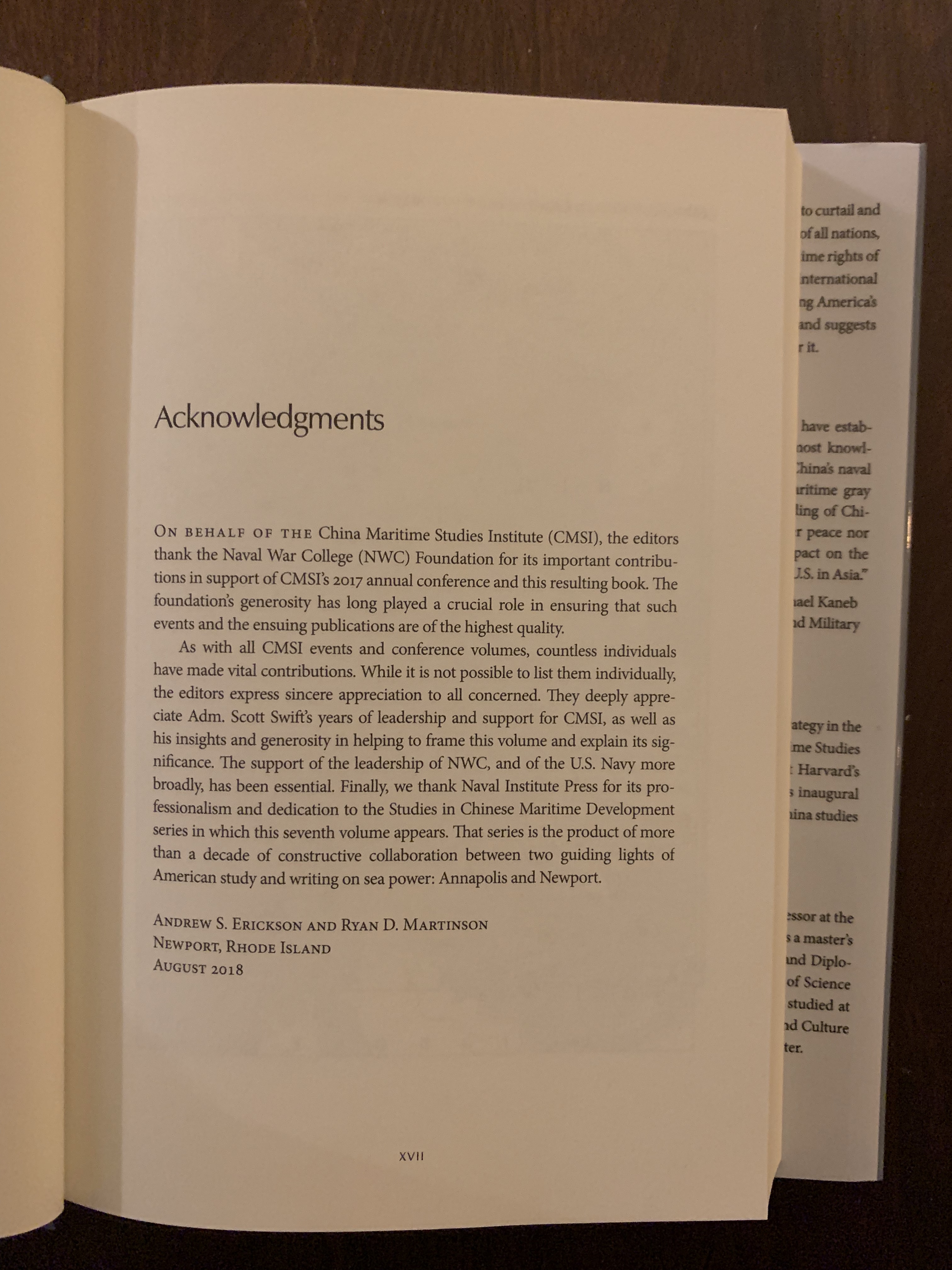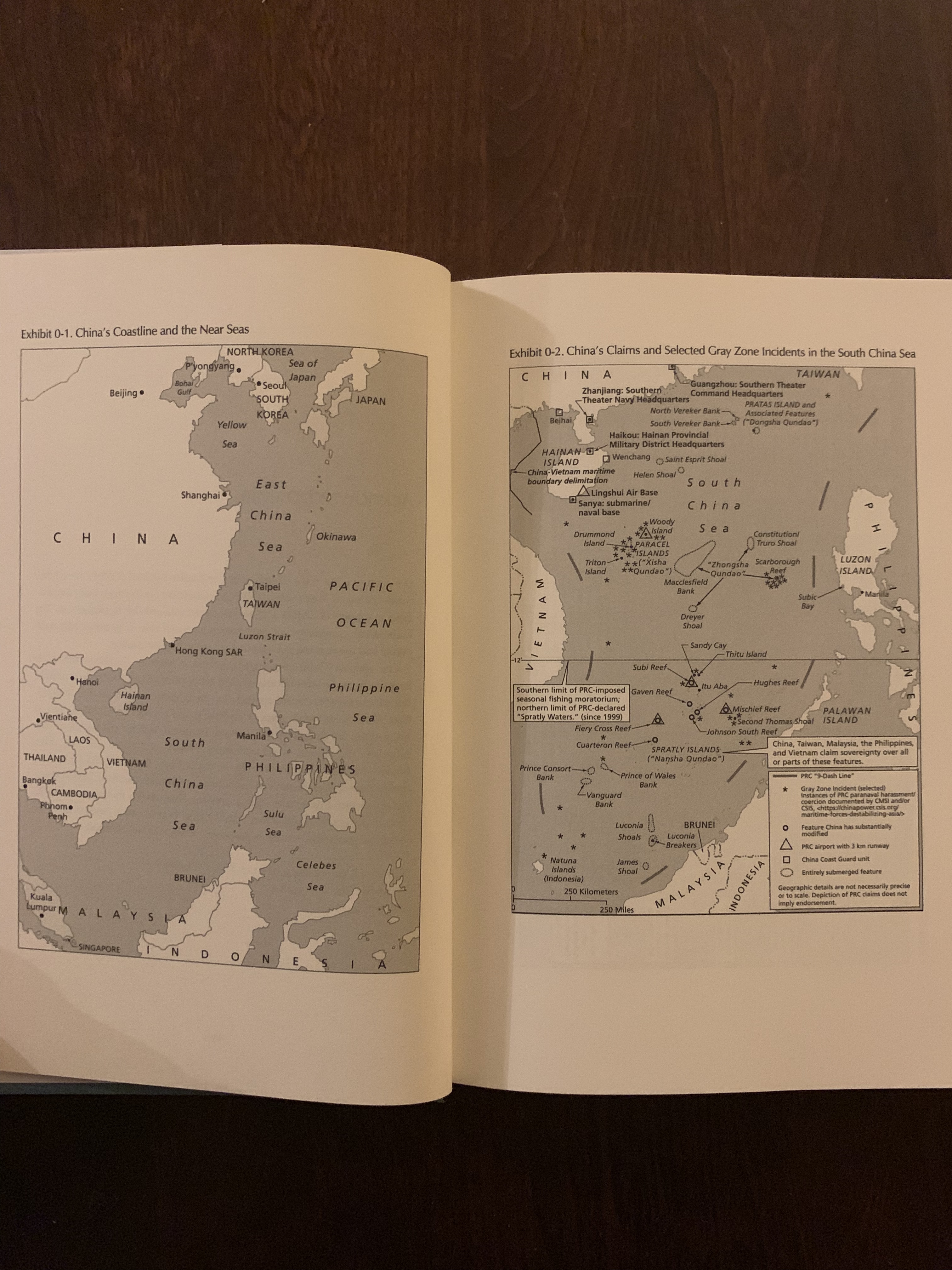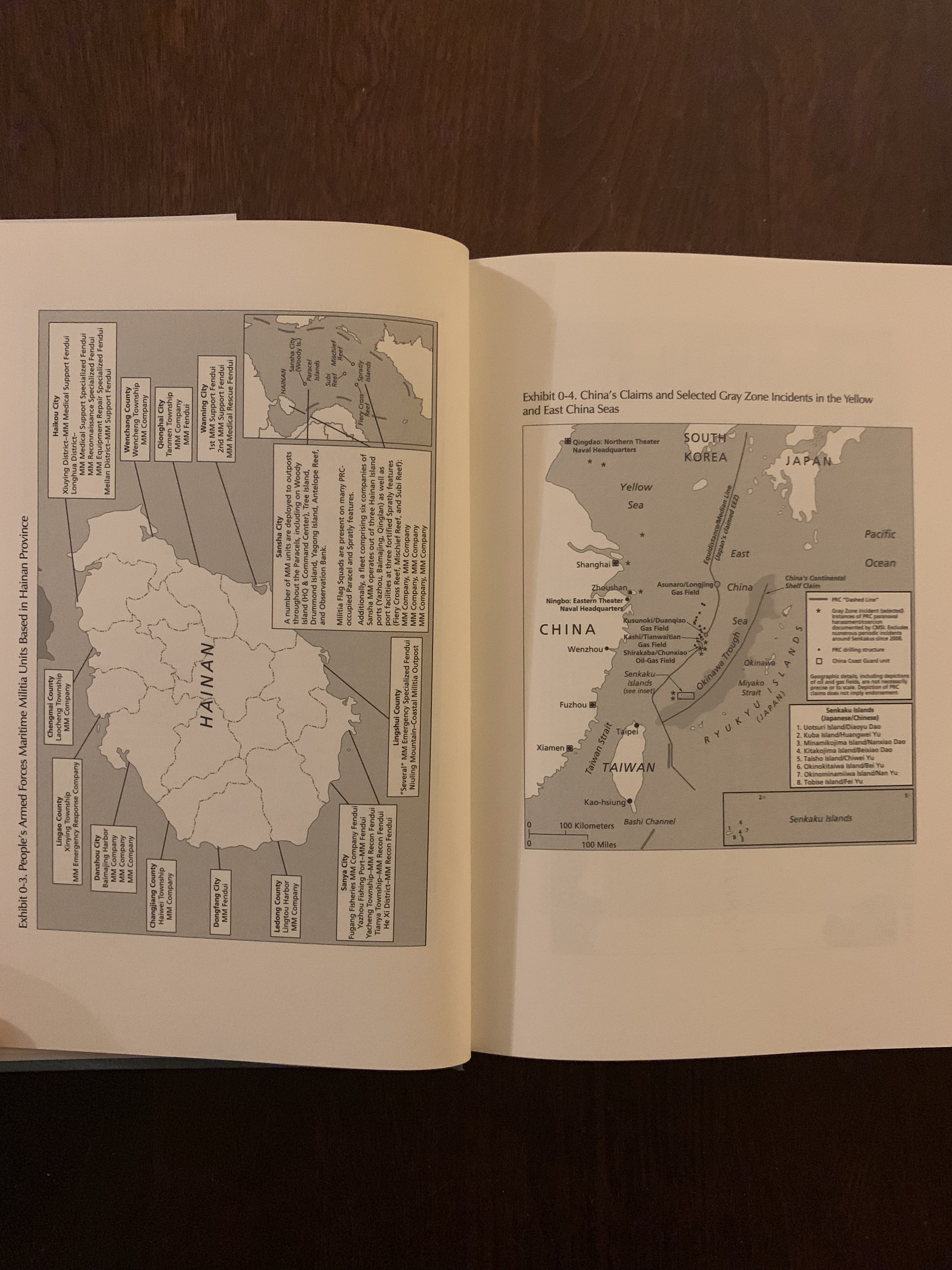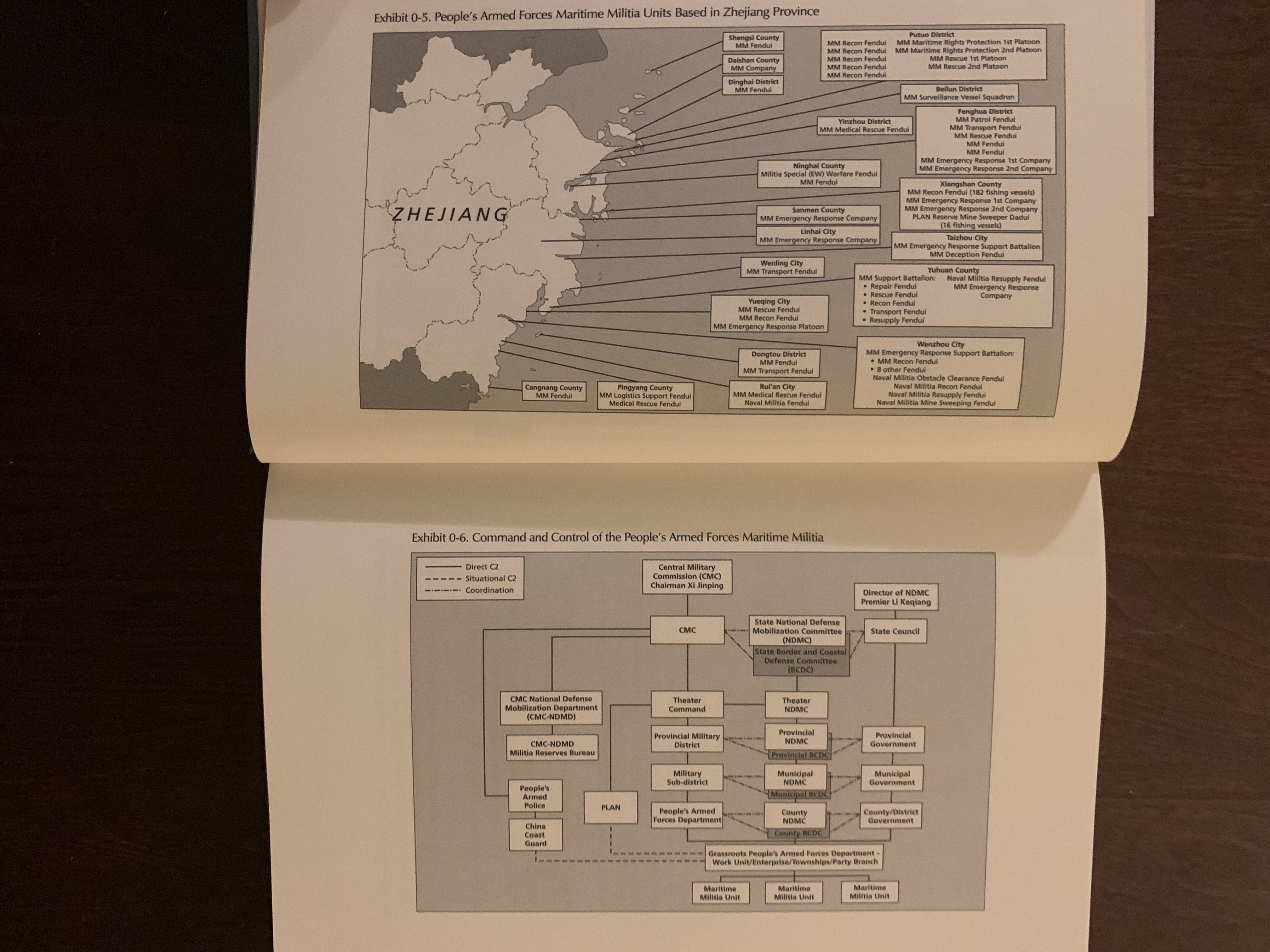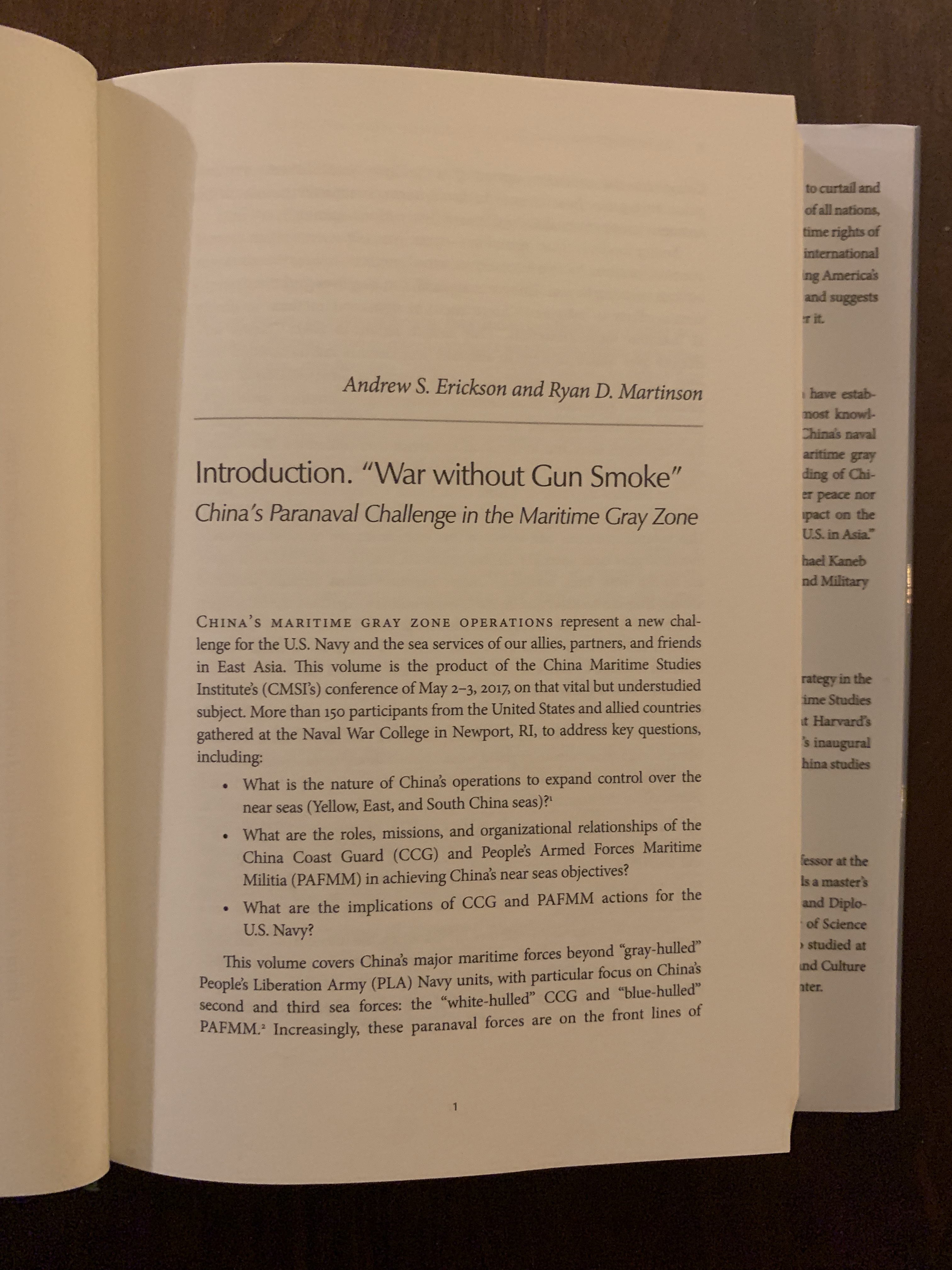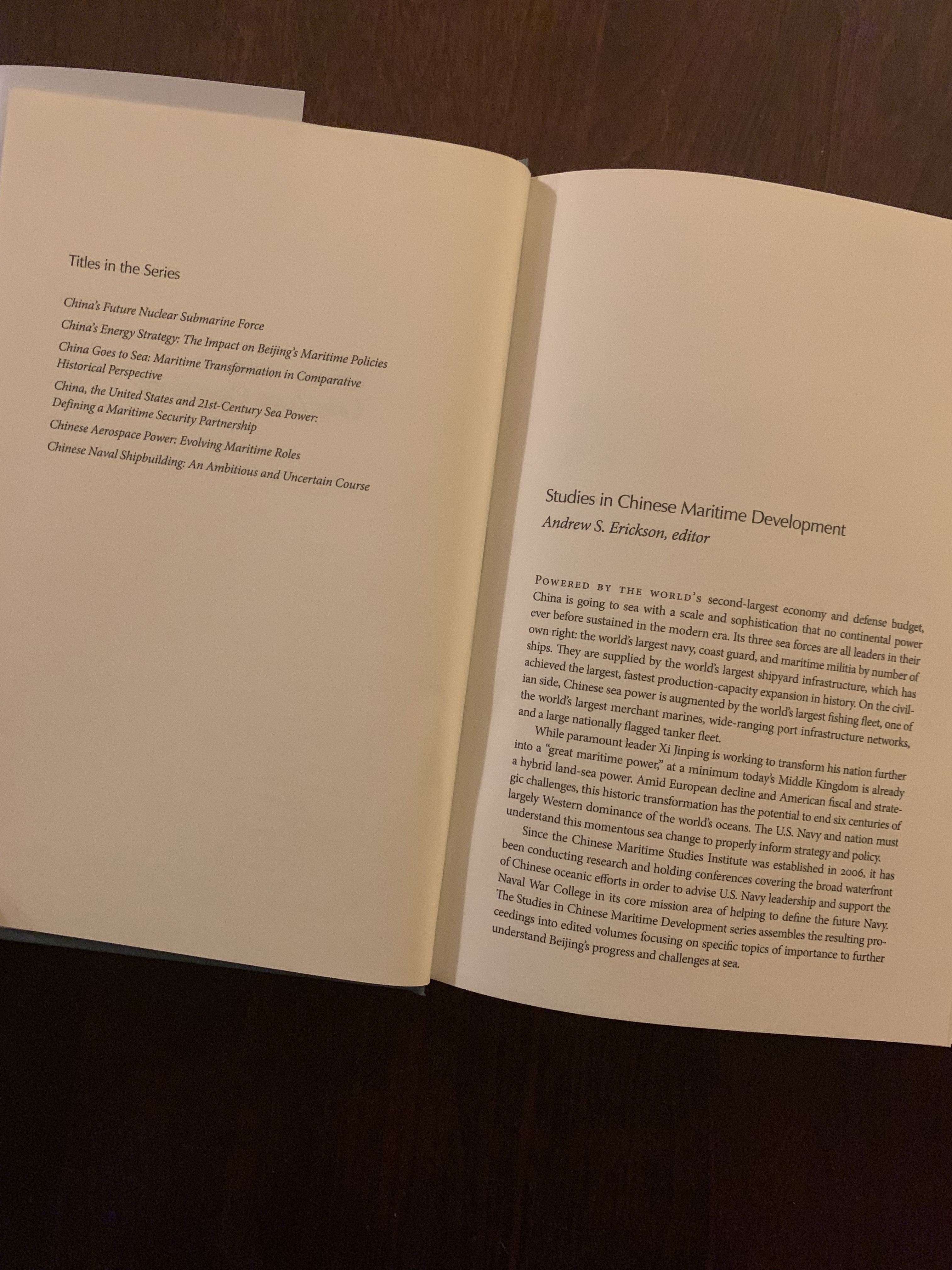Latest CMSI Volume—“China’s Maritime Gray Zone Operations”—Now Available for Preorder on Amazon
Andrew S. Erickson and Ryan D. Martinson, China’s Maritime Gray Zone Operations (Annapolis, MD: Naval Institute Press, 2019).
As with the previous six volumes in our “Studies in Chinese Maritime Development” series, an Amazon Kindle edition will be available.
Eventually, there will also be an authorized Chinese-language translation through Ocean Press, China’s leading maritime publisher.
- Andrew S. Erickson and Ryan D. Martinson, “Introduction: ‘War Without Gun Smoke’—China’s Paranaval Challenge in the Maritime Gray Zone,” 1-11.
- Joshua Hickey, Andrew S. Erickson, and Henry Holst, “China Maritime Law Enforcement Surface Platforms: Order of Battle, Capabilities, and Trends,” 108-132.
- Andrew S. Erickson and Ryan D. Martinson, “Conclusion: Options for the Definitive Use of U.S. Sea Power in the Gray Zone,” 291-301.
China’s maritime “gray zone” operations represent a new challenge for the U.S. Navy and the sea services of our allies, partners, and friends in maritime East Asia. There, Beijing is waging operations conducted to alter the status quo without resorting to war, an approach that some Chinese sources term “War without Gun Smoke” (一场没有硝烟的战争). Already winning in important areas, China could gain far more if left unchecked. One of China’s greatest advantages thus far has been foreign difficulty in understanding the situation, let alone determining an effective response. With contributions from some of the world’s leading subject matter experts, this volume aims to close that gap by explaining the forces and doctrines driving China’s paranaval expansion.
The book therefore covers in-depth China’s major maritime forces beyond core gray-hulled Navy units, with particular focus on China’s second and third sea forces: the “white-hulled” Coast Guard and “blue-hulled” Maritime Militia. Increasingly, these paranaval forces are on the frontlines of China’s seaward expansion, operating in the “gray zone” between war and peace: where the greatest action is. Beijing works constantly in peacetime (and possibly in crises short of major combat operations with the United States) to “win without fighting” and thereby to further its unresolved land feature and maritime claims in the Near Seas (Yellow, East, and South China Seas). There is an urgent need for greater understanding of this vital yet under-explored topic: this book points the way.

Volume 7 in Studies in Chinese Maritime Development series
March 2019 | 336 pp. | 6 x 9 | China and the Asia-Pacific
Maps | Hardcover
ASIN: 1591146933
ISBN-13: 978-1591146933
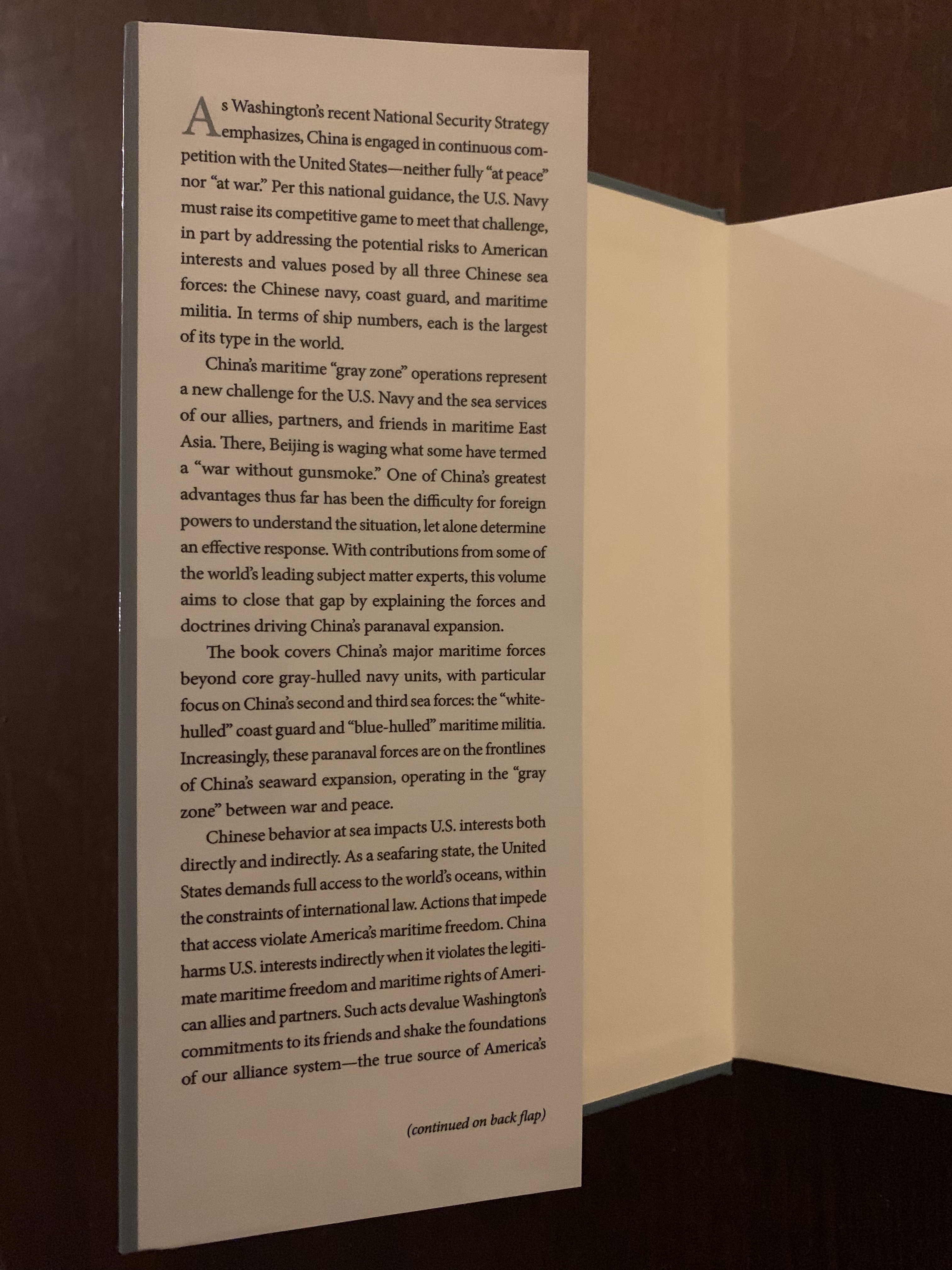
BOOK DESCRIPTION
As Washington’s new National Security Strategy emphasizes, China is engaged in continuous competition with the United States–neither fully “at peace” nor “at war.” Per this national guidance, the U.S. Navy must raise its competitive game to meet that challenge, in part by addressing the potential risks to American interests and values posed by all three Chinese sea forces: the Navy, Coast Guard, and Maritime Militia. In terms of ship numbers, each is the largest of its type in the world.
China’s maritime “gray zone” operations represent a new challenge for the U.S. Navy and the sea services of our allies, partners, and friends in maritime East Asia. There, Beijing is waging what some Chinese sources term a “war without gunsmoke.” One of China’s greatest advantages thus far is the difficulty for foreign powers to understand the situation, let alone determine an effective response. With contributions from some of the world’s leading subject matter experts, this volume aims to close that gap by explaining the forces and doctrines driving China’s paranaval expansion.
This book covers China’s major maritime forces beyond core gray-hulled Navy units, with particular focus on China’s second and third sea forces: the “white-hulled” Coast Guard and “blue-hulled” Maritime Militia. Increasingly, these paranaval forces are on the frontlines of China’s seaward expansion, operating in the “gray zone” between war and peace.
Chinese behavior at sea harms U.S. interests both directly and indirectly. As a seafaring state, America demands maximal access to the world’s oceans within the constraints of international law. Actions that impede that access violate America’s maritime freedom. China harms U.S. interests indirectly when it violates the legitimate maritime freedom and maritime rights of its allies and partners. Such acts devalue Washington’s commitments to its friends and shake the foundations of our alliance system–the true source of America’s global influence. Moreover, China’s efforts to curtail and infringe upon both the maritime freedom of all nations including the United States and the maritime rights of its neighbors undermines the rules-based international order. This volume concludes by examining America’s response to Beiing’s gray zone coercion and suggests what U.S. policymakers can do to counter it.
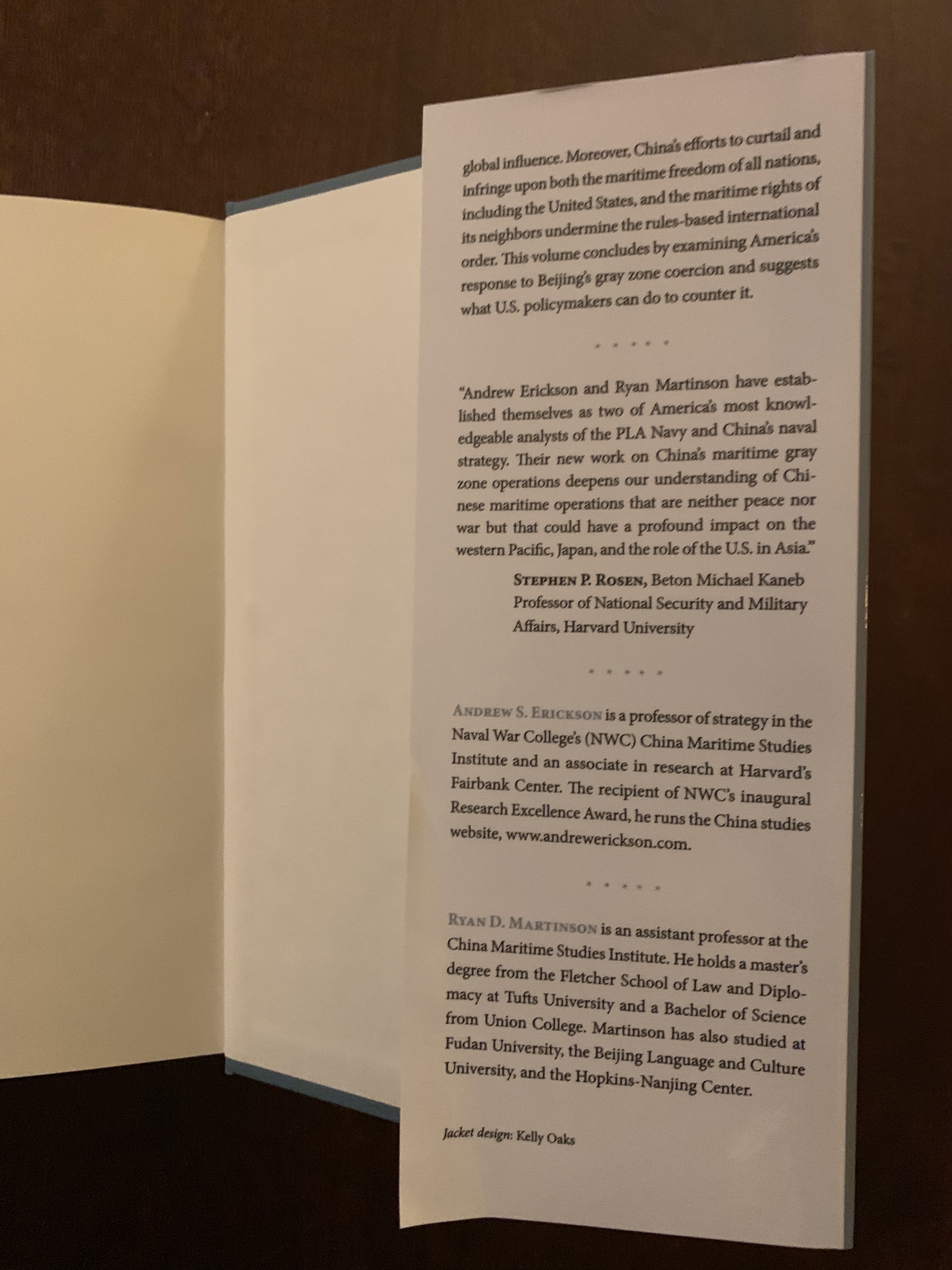
BLURBS
“How can the lightly armed white-hulled and blue-hulled ships of China’s coast guard and maritime militia defeat the heavily armed gray-hulled navies of the U.S. and its allies? Nowhere is this urgent question explored more exhaustively than in this incisive book. It should serve as a wake-up call for the American military.”
—J. William Middendorf, former Secretary of the Navy
“Many fret and opine about China’s gray zone behavior and strategy, yet few know and understand what is at play and in play in that space between peace and war. China’s Maritime Gray Zone Operations is a timely and extraordinarily valuable resource for both new and experienced operators and policymakers who will navigate the gray zone challenge in the years ahead.”
—Admiral Gary Roughead, U.S. Navy (Ret.), Hoover Institution Fellow and former Chief of Naval Operations
“Who needs the CIA? Maritime competition represents the front lines in the struggle for influence between China and the United States. Gray hulls are not the only way Beijing tries to shift the balance. China’s Maritime Gray Zone Operations provides as comprehensive an assessment of the challenge as one might expect from Langley.”
—James Jay Carafano, Ph.D., The Heritage Foundation
“Andrew Erickson and Ryan Martinson have established themselves as two of America’s most knowledgeable analysts of the PLA Navy and China’s naval strategy. Their new work on China’s maritime gray zone operations deepens our understanding of Chinese maritime operations that are neither peace nor war but that could have a profound impact on the western Pacific, Japan, and the role of the U.S. in Asia.”
—Stephen P. Rosen, Beton Michael Kaneb Professor of National Security and Military Affairs, Harvard University
“An informative and striking book, which provides many eye-opening thoughts on China’s crafty and worrisome ‘gray zone’ strategy. A great focus is placed on practical countermeasures…. A good guideline for the planning and operations of frontline sailors.”
—Vice Admiral Yoji Koda, Japan Maritime Self-Defense Force (JMSDF) (Ret.) and former Commander-in-Chief, JMSDF Fleet
“This is an excellent account of how China is using its navy, coast guard, and maritime militia to expand its control and use of adjoining sea areas and exclude others from their use of sea areas legally recognized.”
—Andrew W. Marshall, retired, former Director of Net Assessment, Department of Defense
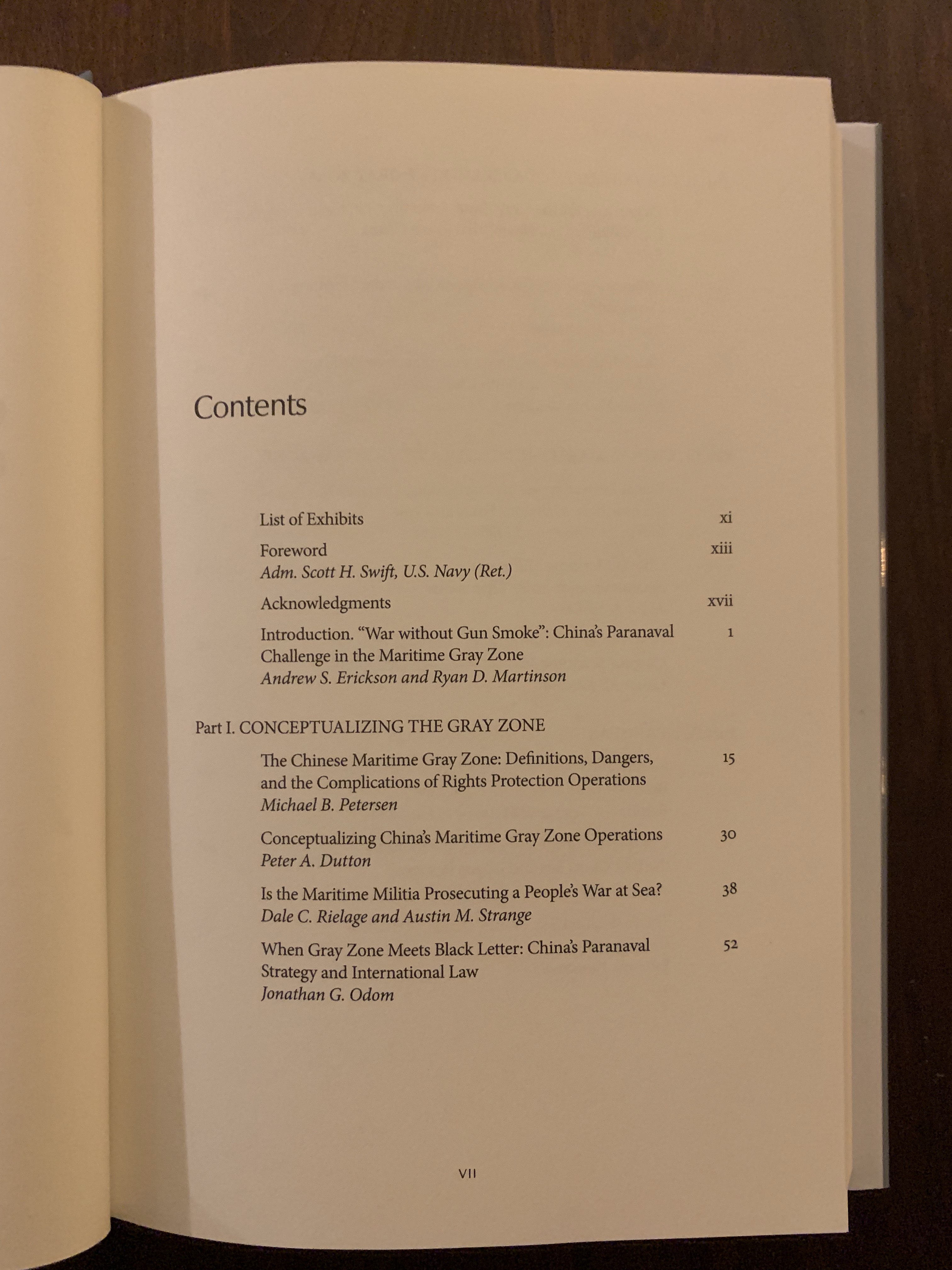
ABOUT THE EDITORS
Andrew S. Erickson is professor of strategy in the Naval War College (NWC)’s China Maritime Studies Institute (CMSI) and an associate in research at Harvard’s Fairbank Center. The recipient of NWC’s inaugural Research Excellence Award, he runs the China studies website www.andrewerickson.com.
Ryan D. Martinson is an assistant professor at CMSI. He holds a master’s degree from the Fletcher School of Law and Diplomacy at Tufts University and a bachelor’s of science from Union College. Martinson has also studied at Fudan University, the Beijing Language and Culture University, and the Hopkins-Nanjing Center.
ABOUT THE AUTHORS
Morgan Clemens is a Research Analyst at SOS International LLC.
Peter A. Dutton, a retired U.S. Navy Commander and judge advocate, is Professor and Director at CMSI.
Matthew Funaiole is a fellow with the China Power Project at the Center for Strategic and International Studies (CSIS).
Bonnie S. Glaser is senior adviser for Asia and director of CSIS’s China Power Project.
Joshua Hickey is a senior analyst for the Department of the Navy with over fifteen years’ subject matter experience.
Henry Holst is a junior analyst for the Department of the Navy.
Conor M. Kennedy is a research associate at CMSI.
Adam P. Liff is an assistant professor at Indiana University’s School of Global and International Studies and an associate in research at Harvard’s Reischauer Institute of Japanese Studies.
Michael Mazarr is a senior political scientist and associate director of the strategy and doctrine program at the RAND Corporation’s Arroyo Center.
Barney Moreland, a retired Captain who served as the first U.S. Coast Guard Liaison Officer in Beijing, is the Senior Intelligence Analyst at U.S. Pacific Fleet Headquarters.
Lyle J. Morris is a senior policy analyst at RAND.
Cdr. Jonathan G. Odom, USN, is a judge advocate and military professor at the Asia-Pacific Center for Security Studies.
Michael B. Petersen is the founding director Russia Maritime Studies Institute and an associate professor in the Center for Naval Warfare Studies at NWC.
Capt. Dale C. Rielage, USN, is Director for Intelligence and Information Operations, U.S. Pacific Fleet.
Mark A. Stokes, a retired U.S. Air Force Lieutenant Colonel, is Executive Director of the Project 2049 Institute.
Austin M. Strange is a Ph.D. candidate in Harvard University’s Government Department.
Admiral Tomohisa Takei, Japan Maritime Self-Defense Force (JMSDF) (Ret.) concluded his thirty-seven-year naval career as the JMSDF’s 32nd Chief of Staff, and is now a professor and distinguished international fellow at NWC.
Michael Weber a foreign affairs analyst and Presidential Management Fellow at the Congressional Research Service.
Capt. Katsuya Yamamoto, JMSDF, who served as a Defense/Naval Attaché in Beijing, is a liaison officer and international military professor at NWC.
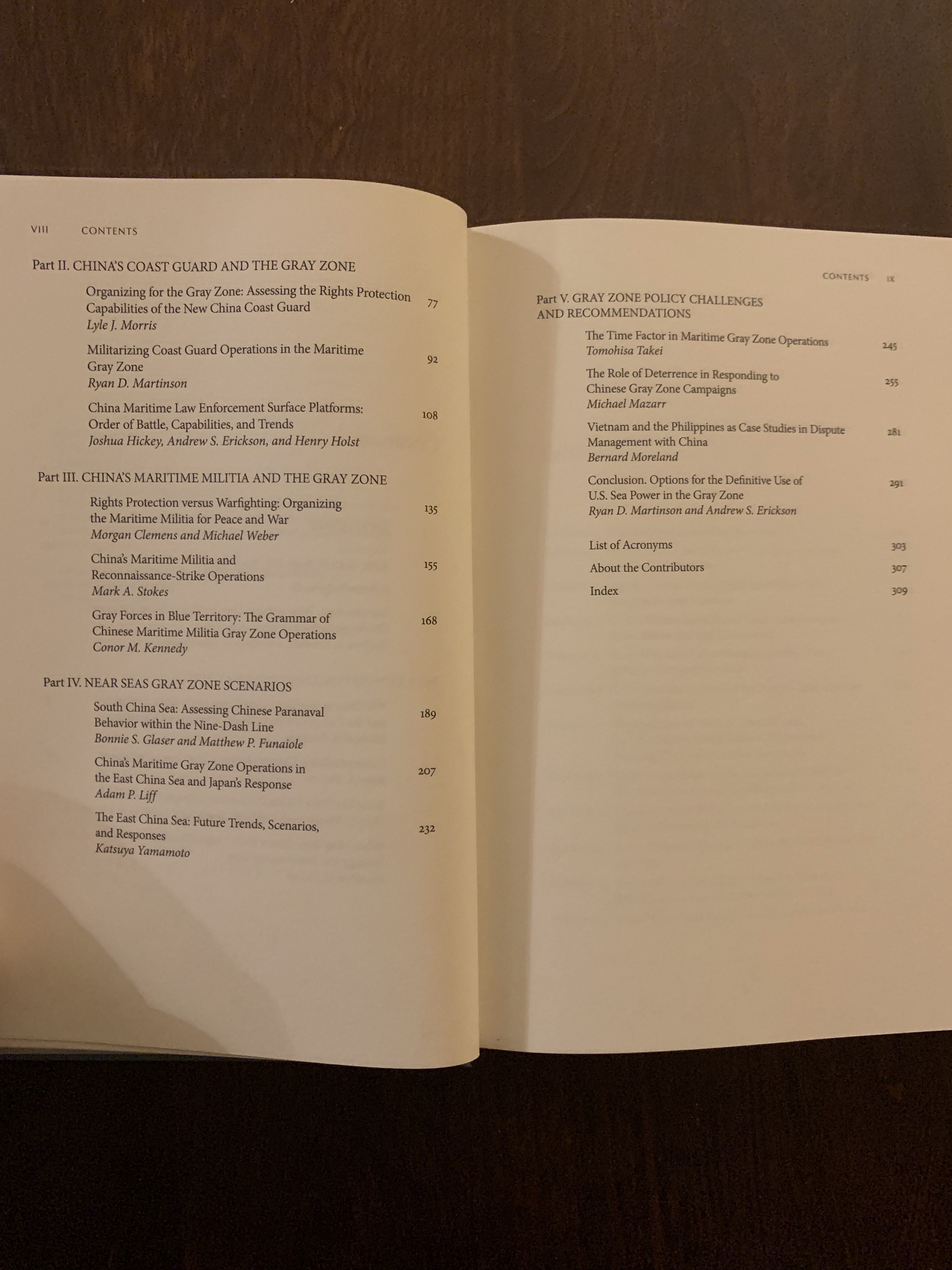
Previous Titles in the Series
China’s Future Nuclear Submarine Force
China’s Energy Strategy: The Impact on Beijing’s Maritime Policies
China Goes to Sea: Maritime Transformation in Comparative Historical Perspective
China, the United States and 21st-Century Sea Power: Defining a Maritime Security Partnership
Chinese Aerospace Power: Evolving Maritime Roles
Chinese Naval Shipbuilding: An Ambitious and Uncertain Course
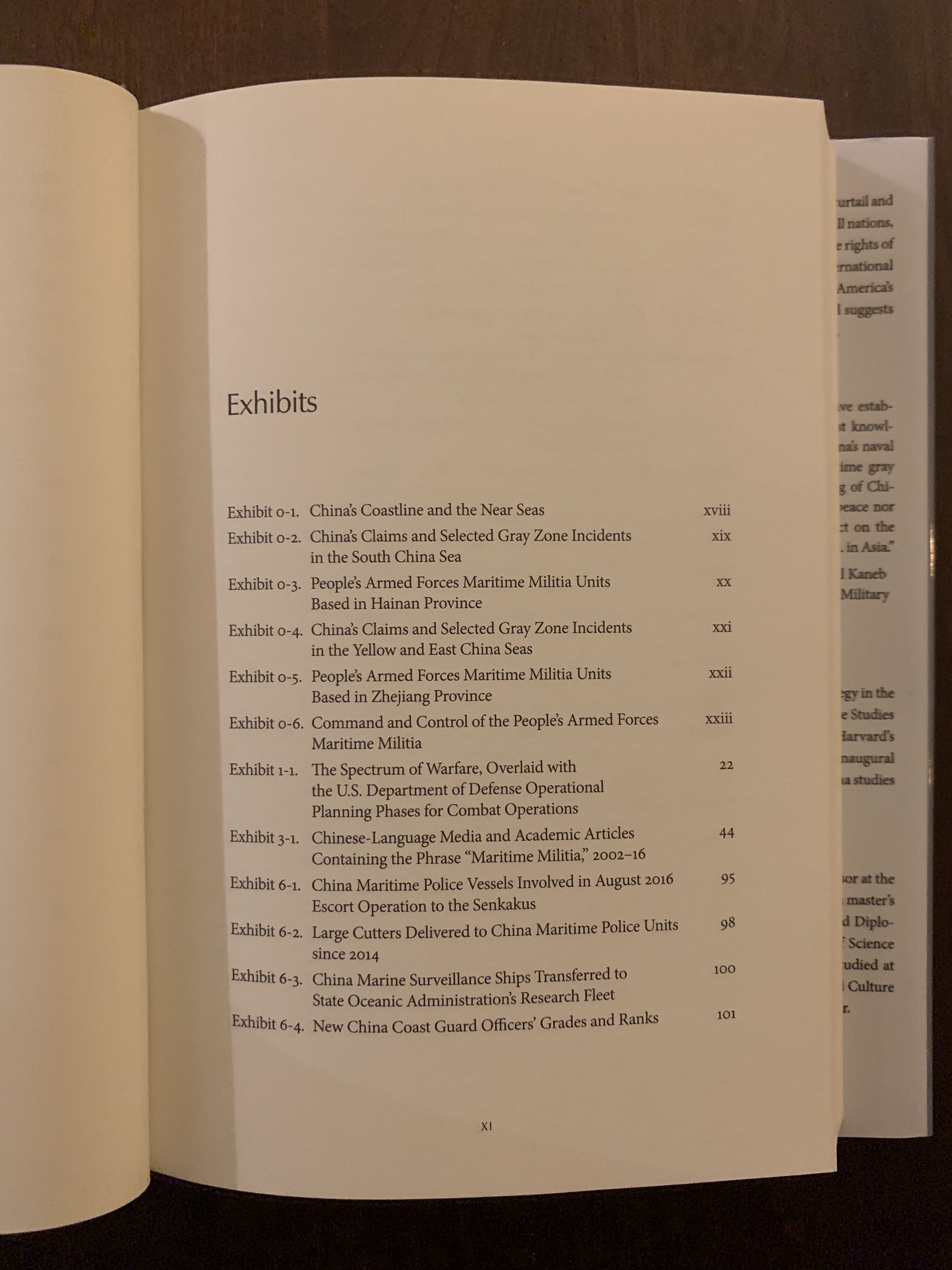
RELATED READING
BACKGROUND AND SUMMARY OF VOLUME, AS WELL AS EDITORS’ FURTHER ANALYSIS AND POLICY RECOMMENDATIONS:
Ryan D. Martinson and Andrew S. Erickson, “Re-Orienting American Sea Power for the China Challenge,” War on the Rocks, 10 May 2018.
Summary: this article proposes a new set of tools for countering China’s maritime gray zone expansion.
As a seafaring state, America demands maximal access to the world’s oceans within the constraints of international law. Though seldom recognized, U.S. efforts to defend its interest in maritime freedom in the Western Pacific have been fairly successful. When the People’s Republic of China unlawfully draws “fences” around the sea, U.S. warships steam through the fences. Beijing recognizes the seriousness of America’s position, and thus far has generally yielded.
However, when it comes to helping its allies and partners protect themselves against Chinese encroachment, the United States has a mixed record. Since 2006, Beijing has dramatically expanded the frontiers of its control in the East and South China Seas. To pursue its irredentist agenda, Beijing has largely relied on unarmed or lightly armed paranaval forces — coast guard and militia — conducting operations in what has been described as the “gray zone” between war and peace. Despite the robust presence of American sea power in contested areas of maritime East Asia, the United States has largely failed to halt China’s bullying behavior. This failure devalues Washington’s commitments to its friends and shakes the foundations of the U.S. alliance system — the true source of American global influence.
To better aid its allies and partners, Washington should consider expanding its catalogue of peacetime maritime operations. Passive presence has proved inadequate. In some cases, American policymakers may need to place U.S. forces on the front lines, where they can play a more direct role helping other states counter China’s seaward expansion. … …
